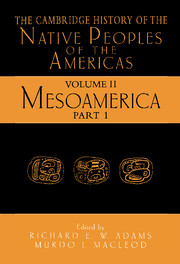Book contents
- Frontmatter
- Contents
- List of Illustrations
- Part I
- 1 Introduction to a Survey of the Native Prehistoric Cultures of Mesoamerica
- 2 The Paleoindian and Archaic Cultures of Mesoamerica
- 3 The Preclassic Societies of the Central Highlands of Mesoamerica
- 4 The Precolumbian Cultures of the Gulf Coast
- 5 The Maya Lowlands: Pioneer Farmers to Merchant Princes
- 6 The Central Mexican Highlands from the Rise of Teotihuacan to the Decline of Tula
- 7 Western and Northwestern Mexico
- 8 Cultural Evolution in Oaxaca: The Origins of the Zapotec and Mixtec Civilizations
- 9 The Southeast Frontiers of Mesoamerica
- 10 The Maya Highlands and the Adjacent Pacific Coast
- 11 The Aztecs and Their Contemporaries: The Central and Eastern Mexican Highlands
- Index
6 - The Central Mexican Highlands from the Rise of Teotihuacan to the Decline of Tula
Published online by Cambridge University Press: 28 March 2008
- Frontmatter
- Contents
- List of Illustrations
- Part I
- 1 Introduction to a Survey of the Native Prehistoric Cultures of Mesoamerica
- 2 The Paleoindian and Archaic Cultures of Mesoamerica
- 3 The Preclassic Societies of the Central Highlands of Mesoamerica
- 4 The Precolumbian Cultures of the Gulf Coast
- 5 The Maya Lowlands: Pioneer Farmers to Merchant Princes
- 6 The Central Mexican Highlands from the Rise of Teotihuacan to the Decline of Tula
- 7 Western and Northwestern Mexico
- 8 Cultural Evolution in Oaxaca: The Origins of the Zapotec and Mixtec Civilizations
- 9 The Southeast Frontiers of Mesoamerica
- 10 The Maya Highlands and the Adjacent Pacific Coast
- 11 The Aztecs and Their Contemporaries: The Central and Eastern Mexican Highlands
- Index
Summary
THE SETTING
I concentrate on a region of about 50,000 square kilometers, roughly the size of New Hampshire and Vermont combined, a little less than a third the size of England. It runs some 260 kilometers east-west by 170 kilometers north-south, covering the state of Mexico, southern Hidalgo, central Puebla, Tlaxcala, and Morelos. It is centered on Mexico City and the Basin of Mexico, whose flat, broad floor slopes up from about 2,240 meters above sea level (Map 6.1). Interconnected shallow lakes formerly occupied the central part of the Basin; Xaltocan and Zumpango to the north and Xochimilco and Chalco to the south, all connecting with the somewhat lower Lake Texcoco, which was moderately salty owing to the absence of exterior drainage. The Basin is limited on the west, south, and east by high mountains that extend above 3,000 meters, including in the southeast the snowcapped volcanos Iztaccíhuatl and Popocatépetl (5,452 meters). The northwestern margin is not well marked, and a low divide leads to the drainage of the Tula region, whose streams ultimately flow into the Gulf of Mexico. On the northeast the Teotihuacan Valley runs by a gentle gradient into the plains of central Puebla and Tlaxcala. These plains in turn stretch east and northeastward toward the Gulf Coast and southeastward to southern Puebla and Oaxaca. Much of central Puebla is part of the Basin of Mexico drainage, which covers about 12,000 square kilometers in total (Lorenzo 1968). It is better, from a cultural point of view, to define the Basin as a more compact area that includes the Teotihuacan Valley and is centered on the lakes, running about 80 kilometers north-south by 50–60 kilometers east-west, and covering about 4,000 or 5,000 square kilometers.
West of the Basin lies the Valley of Toluca, whose floor is also relatively flat, at around 2,600 to 2,700 meters (Sugiura 1990:192). The plains of Tlaxcala and central Puebla are a little lower than the Basin, except near La Malinche, which rises to 4,461 meters. To the south is Morelos, significantly lower at about 1,000 to 1,500 meters (Grove 19873:6).
The region as a whole is semi-arid, and rainfall is markedly seasonal, mostly from June to October (Sanders, Parsons, and Santley 1979:82).
- Type
- Chapter
- Information
- The Cambridge History of the Native Peoples of the Americas , pp. 250 - 317Publisher: Cambridge University PressPrint publication year: 2000
- 6
- Cited by



